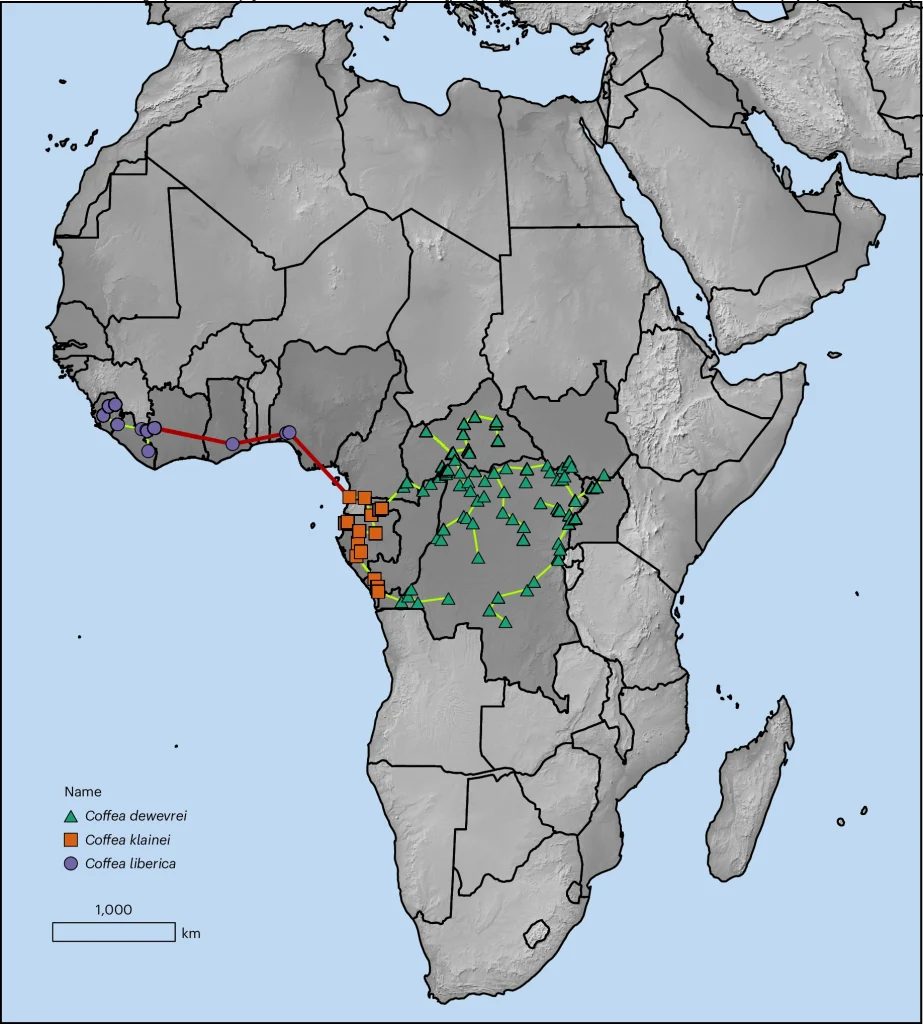The Coffee Family Map and Its Hidden Rarities
Around 60–70% of the world’s commercial coffee production comes from Arabica (Coffea arabica), and 30–40% from Robusta (C. canephora). Beyond these two giants, more than 100 wild and regionally cultivated species are known—many of them threatened with extinction and listed in high-risk categories on the IUCN Red List. These rare species are invaluable genetic resources, offering disease resistance, heat tolerance, and unique flavor profiles that act as an “insurance policy” for the coffee industry in a changing climate. Among them, Liberica (Coffea liberica) has long been considered the “third major” coffee species after Arabica and Robusta. Yet, its global output is tiny, and it has been viewed as difficult to expand in cultivation. Hidden behind this assumption, however, lay a taxonomic misconception. A new study published in Nature Plants has reclassified the Liberica lineage, unlocking its potential in breeding and conservation.
From One Species to Three
Traditionally, Liberica was treated as a single species (C. liberica) with two “varieties.” However, comprehensive analysis combining genomic data, morphology, and geographic distribution has now shown that it is actually three distinct species: Coffea liberica (Liberica), C. dewevrei (commonly known as “Excelsa”), and C. klainei (Klainei). The research team analyzed 55 wild and cultivated accessions using the Angiosperms353 gene set and further examined 2,240 SNPs from 37 accessions to assess population structure. The results were striking—three genetic and morphological clusters emerged, each clearly distinct. This reclassification is more than academic housekeeping; it redraws the blueprint for coffee breeding and conservation strategy.
Geographic and Climatic Niches
The three species show allopatry—their natural ranges do not overlap. C. liberica occurs in West Africa (Sierra Leone to Nigeria), C. dewevrei in Central Africa (Congo to Uganda), and C. klainei in West-Central Africa (Cameroon to Gabon and the Cabinda exclave). They also differ in elevation: C. liberica and C. klainei grow mostly in lowlands (around 300 m), while C. dewevrei is adapted to higher altitudes (average 650 m). Climatically, C. liberica thrives where rainy and dry seasons are distinct, whereas C. dewevrei occurs in regions with more evenly distributed rainfall. This means that climate adaptation is species-specific, breaking the old assumption that Liberica coffee can only grow in certain narrow environments—and opening the door to cultivation in broader conditions.

Flavor, Aroma, and Processing Diversity
The taxonomic update also reshapes our understanding of flavor and aroma. C. dewevrei (Excelsa) has thin fruit pulp and parchment, with small seeds—making it compatible with existing Arabica and Robusta processing equipment and yielding a higher outturn (bean-to-fruit ratio). It is known for fruity, light acidity with spice-like aromatics, well-suited for specialty markets. C. liberica delivers a full-bodied cup with heavy notes reminiscent of jackfruit and dark chocolate, often used to add depth in blends. C. klainei, while not yet common in trade, may harbor unique flavor traits worth exploring. For roasters, this reclassification expands the flavor palette, potentially giving rise to new coffee categories and brewing experiences.
Production Realities and Expansion Potential
The oft-repeated claim that Liberica makes up “1–2%” of global coffee is outdated. Current data show that C. liberica and C. dewevrei together account for only about 0.01% of global exports (under 1,000 tons). However, production is expanding in Uganda, South Sudan, India, Vietnam, Malaysia, the Philippines, and Indonesia. Scarcity can be a strength in the specialty coffee market, serving as a branding advantage. Moreover, C. dewevrei and hybrids with C. liberica have been reported to exhibit vigorous growth and high yields, suggesting that interspecific breeding could combine novel flavors with resilience—a key advantage in climate-challenged agriculture.
Why Accurate Classification Matters for the Future
The reclassification dramatically reduced the estimated range of the formerly broad “Liberica” grouping—by about 95% for extent of occurrence (EOO) and 93% for area of occupancy (AOO)—justifying a potential IUCN status upgrade to Vulnerable. Healthy populations are critical not only for preserving flavor diversity but also for developing varieties resilient to pests, diseases, and climatic shifts. Protecting coffee’s future starts with accurate classification: knowing exactly which species exist, where they occur, and what traits they carry. With that map in hand, farmers can match crops to environments, consumers can discover new flavor profiles, and researchers can chart sustainable breeding pathways. This study marks a significant step forward for both coffee science and coffee culture—ensuring that in the decades to come, our morning cup will remain both possible and diverse.



コメント